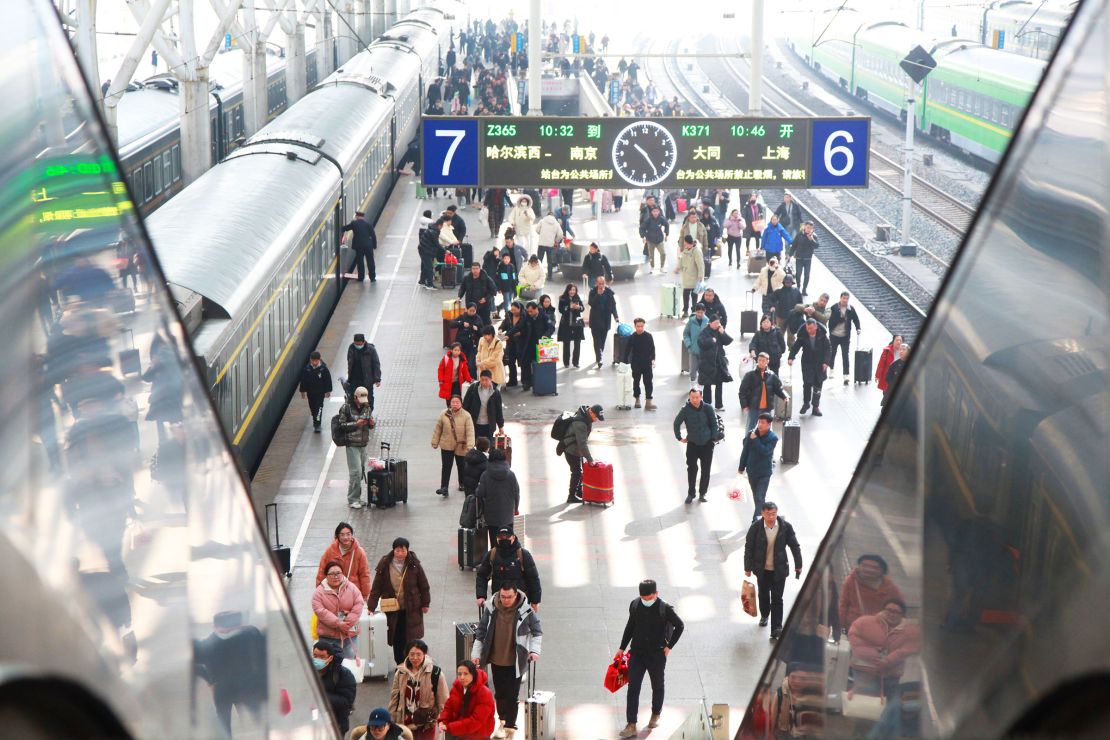Travel and spending during China’s Lunar New Year holiday hit new records this year, giving the government an encouraging boost as it seeks to ramp up the ailing economy.
A total of 501 million trips were made within China during the eight-day travel season, which began on January 28, according to data released by the Ministry of Culture and Tourism on Wednesday. This represented a 5.9% increase from the same period last year. Tourism spending surged by 7%, reaching 677 billion yuan ($93 billion), compared to the previous year.
The average daily spending per trip was 168.9 yuan ($23.2) this year, according to a CNN calculation based on official data, a modest increase from last year’s 166.8 yuan ($22.9). However, the figure was about 5% lower than the pre-pandemic level of 176.9 yuan ($24.3) recorded in 2019.
For cross-border travel, an average of 1.795 million daily trips were made into and out of China during the holiday, according to data from the National Immigration Administration released on Wednesday. The number was slightly higher than the pre-pandemic average of 1.79 million daily trips in 2019. The increase this year was largely driven by foreign visitors, with their numbers rising by 22.9% compared to 2024.
China began rolling out visa-free access to dozens of countries over the past year, in a bid to boost tourism and drive consumption.
“We’re glad to see that as China puts more countries on the visa-free list and fully relaxes and improves visa-free transit policy, the Chinese New Year is becoming a worldwide celebrated festival,” said Chinese Foreign Ministry spokesperson Lin Jian at a regular press briefing on Wednesday.
He added that the number of foreign tourists visiting China during the holiday rose by 150% compared to 2024 to a new high, citing third party data. He did not specify the source of the information.

After a disappointing 2024, Chinese holidaymakers returned to movie theaters during the break.
“With the holiday effect and policy support, sectors such as inbound tourism, film, household appliances and electronics saw solid performance,” Citi analysts said in a Wednesday research note.
A record-breaking 187 million people went to the cinema over the holiday, lifting the box office to a record high of 9.5 billion yuan ($1.32 billion), according to data released by the China Film Administration. Topping the charts was the animated film “Nezha 2,” a sequel to a 2019 hit featuring a folk deity. “Nezha 2” has become the top grossing film in China of all time, according to state broadcaster CCTV.
The world’s second-largest economy continues to face a range of challenges, from job insecurity among the younger generation to sharp downturns in the property sector, once a cornerstone of the country’s economic growth.
Economic woes
Chinese leader Xi Jinping has made “actively expanding domestic consumption” a top priority, as consumer and business sentiment remain subdued.
While the Lunar New Year holiday spending gives government officials a confidence boost as they struggle to turn the economy around, it’s unclear whether this momentum can continue.
“We should not read too much into the positive holiday data, as it could be merely a release of spending power after a weak 2024,” HSBC consumer analysts wrote in a research note Thursday.
Part of the surge in box office revenue can be attributed to the government’s consumption-driving policies aimed at stimulating spending. In December, the China Film Administration launched a public subsidy campaign, while local governments like Beijing and Guangdong distributed cinema vouchers ahead of the holiday.
To boost spending on consumer goods, the Finance Ministry announced in January the allocation of 81 billion yuan ($11.1 billion) for trade-in programs for cars and household appliances, including rice cookers and washing machines.
On the international stage, China is also under immense pressure, particularly from the Trump administration’s imposition this week of a 10% tariff on all imports from the country into the US.
Beijing has hit back against the tariffs, announcing on Tuesday a broad package of economic measures targeting the US, which will go into effect next week. They include a 15% tax on certain types of coal and liquefied natural gas, and a 10% tariff on crude oil, agricultural machinery, large-displacement cars and pickup trucks.
In a State Council meeting on Wednesday, Chinese Premier Li Qiang stressed the need to firmly maintain confidence and coordinate efforts to address domestic economic issues while responding to external challenges, according to state media.









